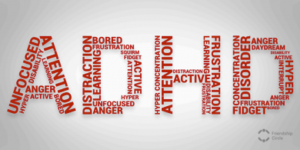Whats the deal with ADHD?
This page was created by Max Fine, a senior at Choate Rosemary Hall in Wallingford, CT. Max’s spirit animal is the panda. Someday, Max will be famous for inventing a machine that can crate energy with very little waste. ADHD Image
The Answer: 11% of children nationwide between the ages of 4 and 17. (The question to this answer will be revealed at the end of this article. No cheating!)
 Attention Deficit Hyperactivity Disorder (ADHD) is a mental disorder that affects children and adults worldwide. (National Institute of Health 2016). The disorder is difficult to treat,and has lifelong consequences for those with it. Another major issue, though, with the disorder is that it is hard to diagnose. While there is some evidence that suggests the genes for the disorder are highly inheritable, there are no tests that exist to accurately and objectively diagnose the condition (Koerth-Baker 2013). Because of this, doctors have to subjectively diagnose ADHD. This causes numerous problems such as multiple visits to a physician, the various costs associated with those visits, and the subjectivity of symptoms. New research, however, conducted by scientists at the university of Nottingham has shown that there could be a quantitative test that can both significantly increase accuracy and speed of ADHD diagnosis (Hall Et. Al 2016).
Attention Deficit Hyperactivity Disorder (ADHD) is a mental disorder that affects children and adults worldwide. (National Institute of Health 2016). The disorder is difficult to treat,and has lifelong consequences for those with it. Another major issue, though, with the disorder is that it is hard to diagnose. While there is some evidence that suggests the genes for the disorder are highly inheritable, there are no tests that exist to accurately and objectively diagnose the condition (Koerth-Baker 2013). Because of this, doctors have to subjectively diagnose ADHD. This causes numerous problems such as multiple visits to a physician, the various costs associated with those visits, and the subjectivity of symptoms. New research, however, conducted by scientists at the university of Nottingham has shown that there could be a quantitative test that can both significantly increase accuracy and speed of ADHD diagnosis (Hall Et. Al 2016).
According to the National Institute of Health, “For a person to receive a diagnosis of ADHD, the symptoms of inattention and/or hyperactivity-impulsivity must be chronic or long-lasting, impair the person’s functioning, and cause the person to fall behind normal development for his or her age” (National Institute of Health 2016). This can be a problem because all three factors of ADHD require a long-term diagnosis, and there is no clear way to objectively gather data on these symptoms. This is why researchers explored the idea of a new neuropsychological test to aid in the diagnosis of ADHD. This test (commonly referred to as the QbTest) measures how patients focus in the presence of distractions (Hall Et. Al 2016). The test requires a computer and several sensors, and measures how patients respond to shapes by pressing a responder button. The computer records response time, but also measures where the patient is looking, based on data from a sensor that is placed on the forehead. (“ADHD Objective,” 2013). While the QbTest is not a standalone diagnostic tool, it can be used to augment traditional diagnoses with objective data, and can eliminate multiple visits to a physician (Hall Et. Al 2016).
This is exciting because the QbTest is the only objective ADHD test approved by both the FDA and the European Commission, and research has shown that it can decrease diagnosis time (Hall Et. Al 2016, “ADHD Objective,” 2013). Because the researchers conducted an audit cycle, (a systematic test format focused on updating the standard of care) it is possible that the QbTest will become a central diagnosis tool for ADHD. The combination of computer programming and low maintenance equipment allows the QbTest to be affordable, and it requires little investment from physicians. This is potentially a significant breakthrough in ADHD diagnosis because the quantitative data the test generates can be stored for future analysis on larger data sets. This could allow physicians to shift diagnosis criteria away from observation, and more toward a scale that can measure the extent of ADHD based on long term data. Overall, with more research, the QbTest has the potential to reduce costs for physicians and patients, and increase the accuracy of ADHD diagnosis.
For Geniuses
Researchers at the University of Nottingham audited the QbTest to check if it could be incorporated into the standard of health (Hall Et. Al 2016). The audit they conducted followed the traditional scientific audit cycle. Patients in the in each group were statistically different in age, and there was no difference in gender between the two groups. Scientists divided patients randomly into two groups, the pre-test group, and the QbTest group. The pre-test group did not receive the QbTest, but received multiple consultations with doctors. The QbTest group did receive the QbTest, but also received multiple consultations. It is important to note that, in the pre-test group, 15 children received a secondary diagnosis of another disorder, and in the QbTest group, 13 children received a secondary diagnosis of another disorder (Hall Et. Al 2016). In the pre-test group, 55% of patients needed two or more consultations to diagnose ADHD, while in the QbTest group, only 18% required two or more consultations. All diagnoses were confirmed in the QbTest group by the 4th consultation, while six children in the pre-test group required more than four (Hall Et. Al 2016). This audit did not consider whether or not the QbTest could confirm negative diagnoses. The study considered a total of 40 cases, with twenty in each group experimental group.
Researchers concluded that the QbTest could be used as a way to augment clinical consultations with objective data. Necessarily, though more research is needed. The study was limited in terms of the number of people in each test group, but researchers believe that the QbTest has the possibility of improving diagnosis, and it is worthy of more rigorous clinical trials (Hall Et. Al 2016).
The Question: How many children nation wide have ADHD as of 2013? (Koerth-Baker 2013).
Impress your friends and family with these three related facts:
Fact 1: ADHD is more common in males than females (National Institute of Health 2016).
Fact 2: Scientists hypothesize that environmental toxins, such as lead, can also cause ADHD (National Institute of Health 2016).
Fact 3: Meditation can help people with ADHD focus (National Institute of Health 2016).
Work Cited
ADHD Objective Test. (2013). Retrieved February 15, 2017, from QbTech website:https://www.qbtech.com
Attention deficit hyperactivity disorder. (2016, March). Retrieved February 8, 2017, from National Institute of Health website: https://www.nimh.nih.gov/health/topics/attention-deficit-hyperactivity-disorder-adhd/index.shtml
Hall, C. L., Selby, K., Guo, B., Valentine, A., Walker, G. M., & Hollis, C. (2016). An objective measure of attention, impulsivity and activity reduces time to confirm ADHD diagnosis in children: a completed audit cycle. Child and Adolescent Mental Health.
Koerth-Baker, M. (2013). The not-so-hidden cause behind the ADHD epidemic. The New York Times, 15.
Media:
ADHD Heritability. (2017). Retrieved February 28, 2017, from ADHD Institute website:
http://www.adhd-institute.com/burden-of-adhd/aetiology/heritability/
Images:
https://az616578.vo.msecnd.net/files/responsive/cover/main/desktop2016/03/26/635945944019746870745588616_adhd.png


Leave a Reply